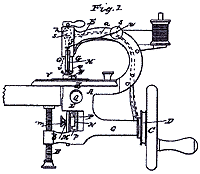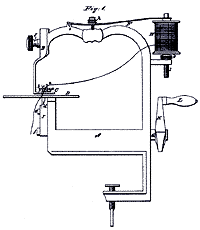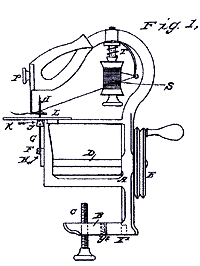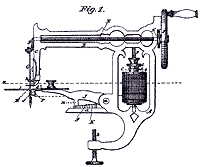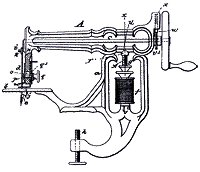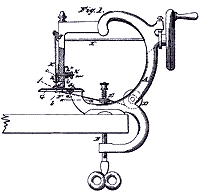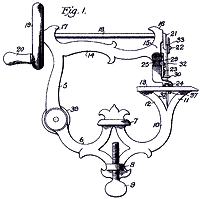


|
Budget
hooked needle machines.
The
design and production of small and inexpensive hooked needle machines
first appeared in the USA in the late 1850s. A number of inventors
and engineers applied their talents to this class of machine during
the subsequent decade. Cheap, practical models were certainly
produced, but it is fair to conclude that commercial success was
only very limited at best. Surviving machines of this type are
scarce today, and this, combined with their diminutive size has
ensured that many of today's enthusiasts are keen to add at least
one of them to their collections. Albert
H. Hook's table clamp machine was patented in November 1858. A
barbed needle penetrated the stitchplate and fabric from below,
and a guide positioned the thread close around the needle. When
the needle descended, the barb caught and carried down a loop
of the thread through the cloth, which was then fed forward one
stitch. The needle again ascended, leaving the loop on it, and
by the same process caught the thread and drew another loop down
through the first. This was repeated as the sewing proceeded. |
|
Hook's 1858 patent. |
Hardy's 1860 patent. |
| Timothy
D. Jackson's 1858 patent once again addressed the design of thread
guides, in this case the guide was to attached directly to the cloth
presser. Machines using this patent were subsequently made and marketed
by the Bartlett Company, New York.
Also
towards the close of the 1850s Edward S. Boynton patented his
own distinctive "clamp-on", barbed needle machine. With
cost cutting in mind, Boynton attached his needle directly to
the crankshaft, thereby creating a simple feed. A variable needle
guide was included, this allowing stitch length adjustment. |
|
Jackson's 1858 patent. |
Boynton's 1859 patent. |
| In
1867 Henry J. Hancock patented a small "clamp-on" machine
which spawned a number of improvements from others. Hancock's design
saw the needle penetrate the fabric from above, unlike the previously
mentioned machines. Although distinctive in appearance, the patent
only claimed one specific feature, this being an adjustable height
stitchplate, employed "to secure a sufficiently firm yet free
and readily adjustable hold of the cloth".
One year later, using Hancock's basic model, Henry P. Lamson claimed a new spring thread guide to yield against the pressure of the needle, which then carried the thread across its path. Also included was a second guide piece to control the path of the thread as well as close the flexible needle barb. Lamson's design boasted a ratchet device to prevent accidental reverse motion, together with a thread tensioning provision. Despite all these improvements, Hancock's adjustable stitchplate was retained. |
|
Hancock's 1867 patent. |
Lamson's 1868 patent. |
| Following
close on Lamson's improvements was George H. Fox and Joseph Hubbard's
August 1868 patent. In this machine, the rather fussy concept of
lifting the entire stitchplate was dispensed with, a new adjustable
height "stripper plate" being incorporated instead.
1870 saw further developments, this time by Jennie L. Lake. The
improvements consisted of, and I quote: |
|
Fox & Hubbard's 1868 patent. |
Lake's 1870 patent. |
| Surviving
examples of the Hancock inspired design have surfaced with many
slightly different features included, therefore it seems reasonable
to speculate that a number of manufacturers produced variants of
this class of machine from the late 1860s for several years. It is of interest to note that Henry J. Hancock did not lose total heart with this type of machine, for in 1901 he initiated a patent for a very similar model. The toy market was clearly in mind this time around, and the resulting "Soeze" model manufactured by Batchelor & Stenson did achieve modest sales. GD |
|
Hancock's 1901 patent. |
© All content copyright protected.

